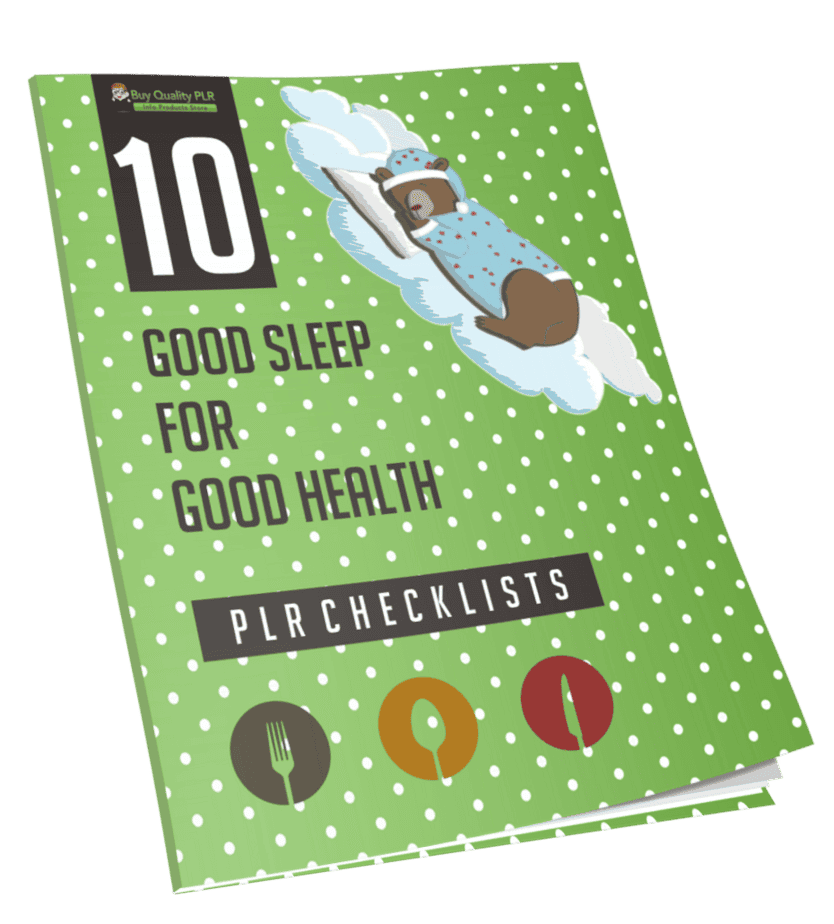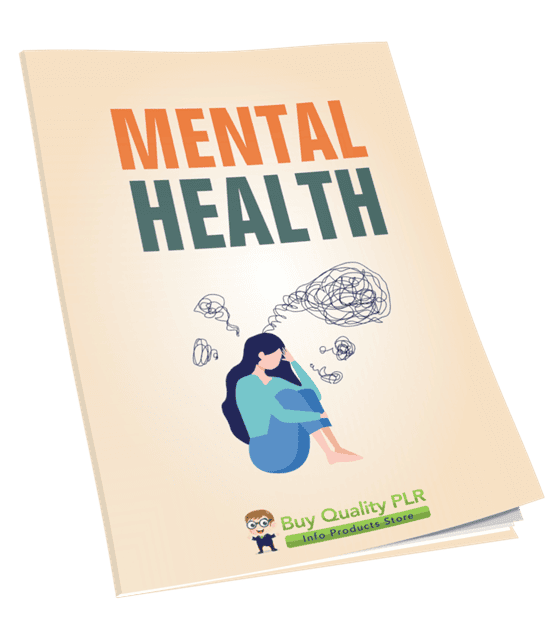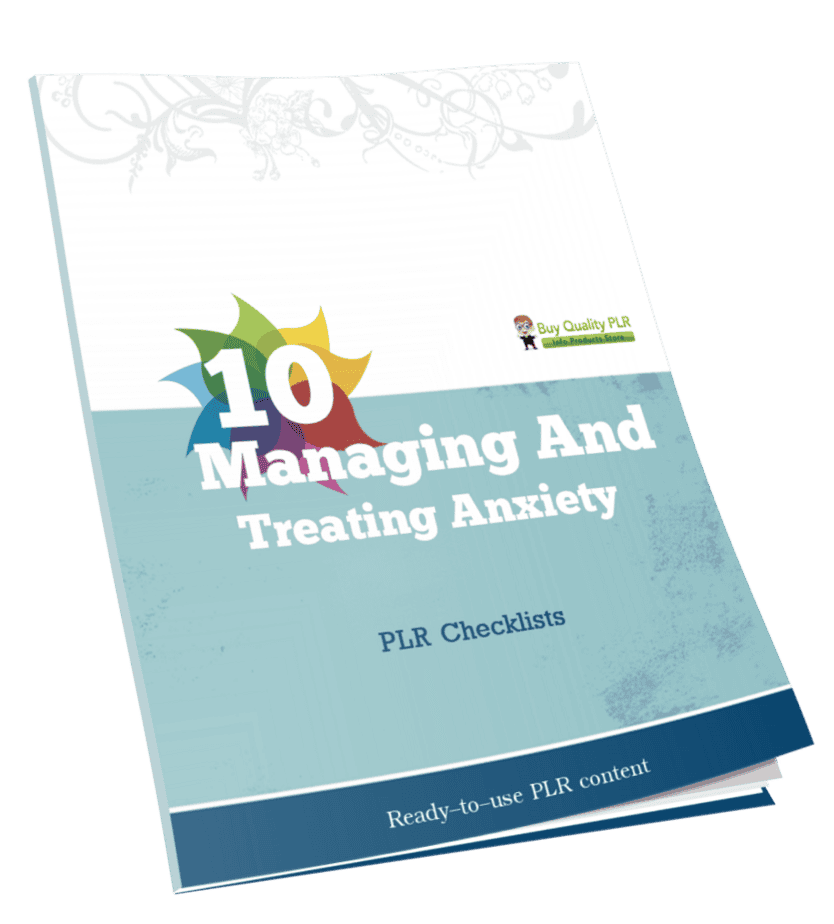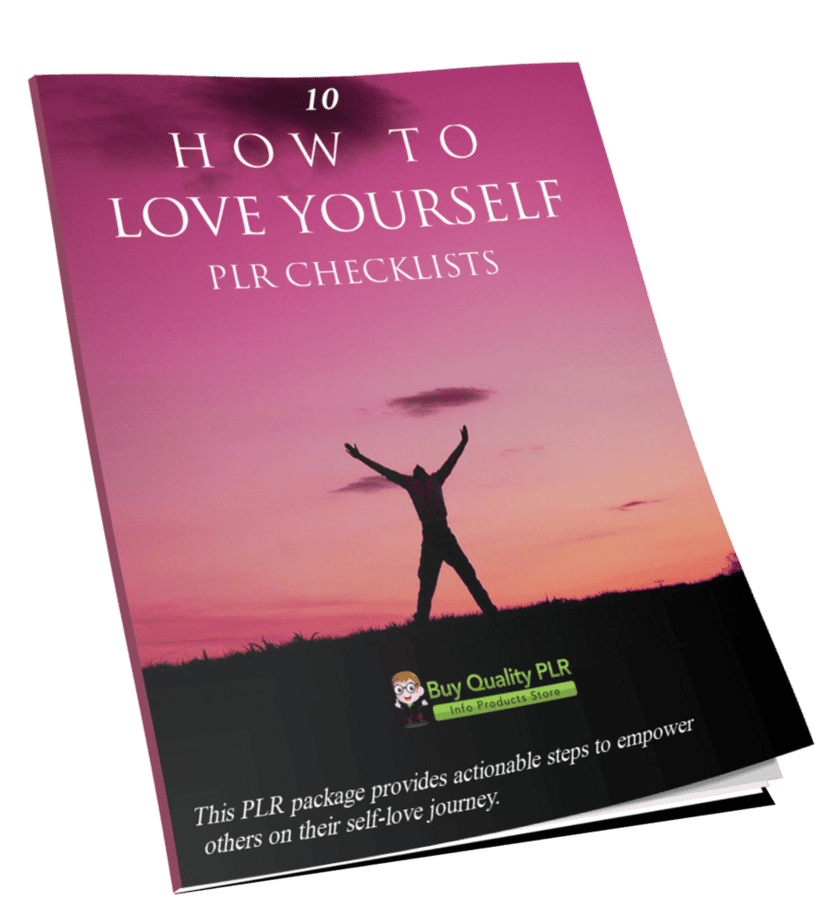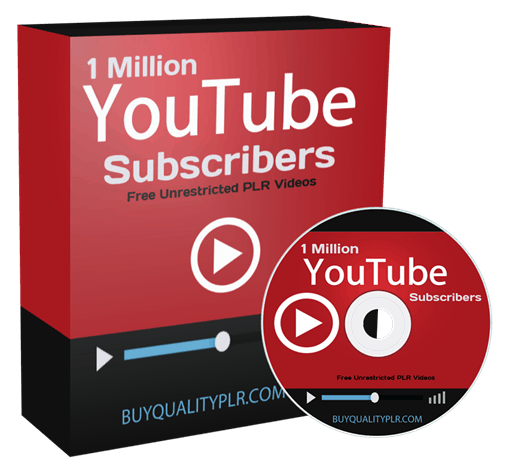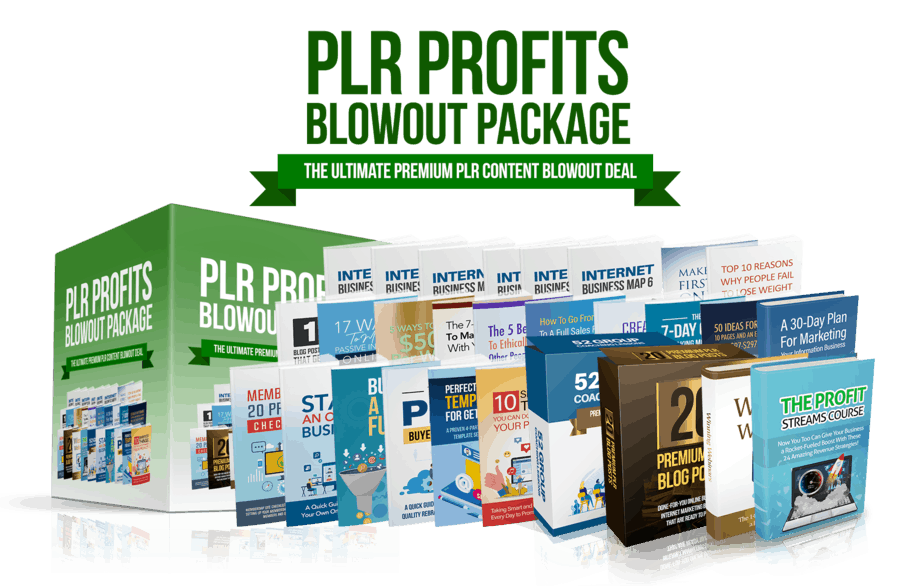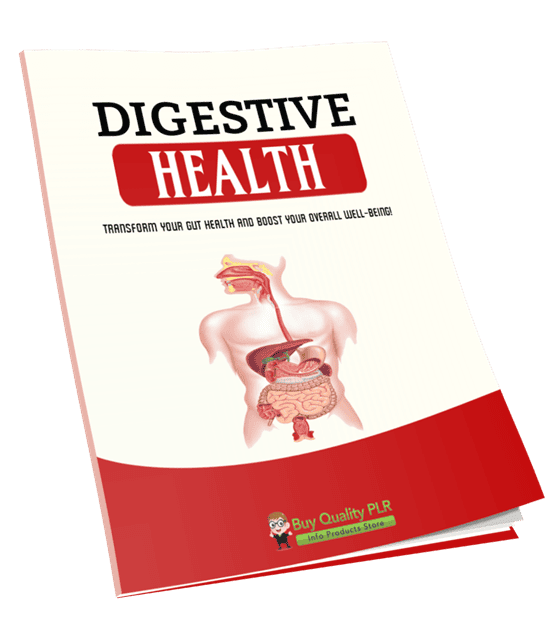
Digestive Health PLR Course 25k Words
in Digestive Health PLR , Health PLR , Health PLR eBooks , PLR Checklists , PLR eBooks , PLR eCourses , PLR List Building Reports , Premium PLR , Premium PLR eBooks , Premium PLR Reports , Premium White Label Brandable PLR Coaching Courses , Private Label Rights ProductsChoose Your Desired Option(s)
has been added to your cart!
have been added to your cart!
#digestivehealthplr #plrcourse #healthandwellness #healthplr #digestivecare #digestivedisorders #digestivesystem
Transform Your Gut Health and Boost Your Overall Well-Being!
Are you or your audience struggling with bloating, indigestion, or discomfort after meals? Digestive health is the cornerstone of vitality and wellness. Introducing the “Digestive Health: A Step-by-Step Guide to a Happy Gut” PLR Course—your ultimate resource for understanding and improving gut health through simple, actionable strategies.
This course provides a comprehensive approach to gut health, combining science-backed insights with practical tips to create lasting change. Whether you’re a health coach, a wellness brand, or an individual looking to improve your digestive well-being, this course is a game-changer.
Presenting…
Digestive Health PLR Course 25k Words
What’s Inside the Digestive Health Course?
Module 1: Understanding Your Digestive System
Gain essential knowledge to identify what’s happening in your gut.
- Know Your Gut Basics: Learn how the digestive system works and the role of organs like the stomach, intestines, and liver.
- What Happens When You Eat? Discover the journey your food takes and how digestion transforms it into energy.
- Signs of a Healthy Gut: Recognize the signs of optimal digestion and learn to listen to your body’s signals.
- Common Digestive Issues: Understand issues like bloating, acid reflux, and constipation—and why they occur.
Module 2: Nutrition for Optimal Digestion
Explore the critical role of diet in gut health.
- Fiber—Your Gut’s Best Friend: Discover the benefits of fiber and how to incorporate high-fiber foods into your meals.
- Hydration Matters: Learn how proper hydration supports digestion and easy ways to stay hydrated.
- Probiotics and Prebiotics: Balance your gut microbiome with probiotic-rich foods like yogurt and prebiotic-rich options like garlic and bananas.
- Foods to Avoid: Identify common culprits that irritate digestion and find ways to enjoy your meals without sacrificing taste.
Module 3: Lifestyle Habits for Better Digestion
Adopt everyday habits that promote gut health.
- Mindful Eating: Slow down, chew thoroughly, and enjoy your meals to improve digestion naturally.
- Regular Physical Activity: Discover how movement, such as post-meal walks, helps digestion.
- Stress and Your Gut: Explore how stress affects digestion and practice relaxation techniques to ease gut discomfort.
- Sleep and Digestion: Learn how quality sleep contributes to gut health and habits to support restful nights.
Module 4: Identifying and Managing Digestive Disorders
Know when to take action and how to handle digestive issues effectively.
- Spotting the Signs: Recognize when gut discomfort signals a deeper issue.
- Understanding Food Sensitivities: Learn how common triggers like gluten and dairy affect digestion and how to identify your sensitivities.
- Simple Remedies for Common Issues: Get practical tips for managing heartburn, bloating, and constipation naturally.
- When to See a Doctor: Know when professional guidance is necessary and how to prepare for your visit.
Module 5: Long-Term Digestive Health
Build a sustainable plan for ongoing gut health.
- Healthy Meal Planning: Create gut-friendly meals that nourish your body and taste great.
- Setting Realistic Goals: Start small and achieve big by setting attainable digestive health goals.
- Keeping a Digestive Health Journal: Track your food intake and symptoms to identify patterns and optimize your well-being.
- Staying Motivated: Get tips and strategies to stay consistent on your gut health journey.
Who Is This Course For?
This course is perfect for:
- Health Coaches and Nutritionists: Enhance your offerings with a ready-to-use resource that adds value to your services.
- Wellness Enthusiasts: Take control of your gut health and discover the connection between digestion and overall vitality.
- Content Creators: Use this high-quality content to grow your audience and establish authority in the health and wellness niche.
What’s Included in the PLR Package?
- Digestive Health PLR Course (23,566 words): A step-by-step guide packed with actionable insights and easy-to-follow modules.
- Checklist (532 words): A practical guide to ensure nothing is overlooked on your path to better gut health.
- FAQs (1,150 words): Comprehensive answers to common questions about digestive health.
- Sales Page (682 words): Professionally written sales copy to help you promote and profit from this course.
How to Profit from This Course
Maximize your investment with these monetization ideas:
- Sell It as a Standalone Course
Offer the course as a complete guide priced between $47–$97 to cater to health-conscious individuals. - Bundle with Complementary Products
Combine this course with meal-planning guides, fitness programs, or stress management content to create a premium package. - Create a Membership Site
Use the course as the foundation for a subscription-based platform that offers ongoing wellness resources. - Repurpose Into Smaller Products
Break the course into mini eBooks, blog posts, or video series for targeted audiences. - Host a Workshop or Webinar
Use the course content as the basis for live or recorded educational sessions to engage your audience. - Build Your Brand
Leverage excerpts as free lead magnets to grow your email list and establish authority in the wellness space.
Why Choose This PLR Course?
- Expertly Researched Content: High-quality material designed to educate and engage your audience.
- Evergreen Demand: Gut health is a timeless topic with growing interest in the wellness industry.
- Fully Customizable: Edit, rebrand, and tailor the content to suit your voice and target audience.
- Low Effort, High Reward: Ready-to-use materials let you focus on promoting and profiting immediately.
Special Offer: Get This Course for Only $14.99!
This is your opportunity to own a premium PLR product in a high-demand niche. Equip yourself or your business with the tools to help others achieve optimal digestive health while building your brand and income.
has been added to your cart!
have been added to your cart!
Here A Sample of Digestive Health PLR Course
Module 1: Understanding Your Digestive System
Step 1: Know Your Gut Basics
Introduction
Understanding the digestive system is the first step toward improving your digestive health. It’s essential to recognize the main organs involved, their roles, and how they work together to process the food you eat. A strong foundation in this knowledge will empower you to make informed decisions about your diet, lifestyle, and overall well-being.
Step-by-Step Guide to Knowing Your Gut Basics
1. Understand the Purpose of the Digestive System
The digestive system’s primary job is to break down the food you eat into nutrients your body can use for energy, growth, and repair. This complex process includes:
- Breaking down large food molecules into smaller, absorbable nutrients.
- Absorbing these nutrients into the bloodstream.
- Eliminating waste and toxins from the body.
2. Explore the Main Organs of Digestion
Each organ in the digestive system has a unique role. Let’s break it down:
a. Mouth
- Digestion begins here as you chew your food.
- Saliva, produced by salivary glands, contains enzymes that start breaking down carbohydrates.
b. Esophagus
- This muscular tube connects your mouth to your stomach.
- When you swallow, the esophagus uses wave-like motions (peristalsis) to push food down into your stomach.
c. Stomach
- The stomach acts as a mixing and storage chamber.
- Gastric juices, including acid and enzymes, break down proteins and prepare food for further digestion.
- It also kills harmful bacteria with its acidic environment.
d. Small Intestine
- This is the powerhouse of nutrient absorption.
- It’s divided into three sections: duodenum (digestion), jejunum (absorption), and ileum (further absorption).
- The small intestine is lined with tiny finger-like projections called villi, which help absorb nutrients into the bloodstream.
e. Liver
- The liver produces bile, a substance that helps break down fats.
- It also processes nutrients absorbed from the small intestine and detoxifies harmful substances.
f. Gallbladder
- The gallbladder stores bile produced by the liver and releases it into the small intestine when needed.
g. Pancreas
- This organ produces digestive enzymes that break down carbohydrates, proteins, and fats.
- It also secretes insulin and glucagon, hormones that regulate blood sugar levels.
h. Large Intestine (Colon)
- The colon absorbs water and electrolytes from indigestible food residues.
- It forms and stores waste material (stool) until it’s eliminated.
i. Rectum and Anus
- The rectum is the final section of the large intestine where waste is stored before elimination.
- The anus is the opening through which waste exits the body.
3. Visualize the Process of Digestion
Picture the journey food takes:
- Chewing and swallowing: Food is broken into smaller pieces and mixed with saliva in the mouth.
- Transport to the stomach: The esophagus moves the food to the stomach, where it is churned and partially digested.
- Nutrient absorption: The small intestine absorbs nutrients into the bloodstream.
- Water absorption and waste elimination: The large intestine absorbs water and prepares waste for elimination.
4. Recognize the Importance of Gut Microbiota
Your digestive system isn’t working alone—it’s supported by trillions of microorganisms, collectively called the gut microbiota.
- These microbes aid in digestion, protect against harmful bacteria, and influence your immune system.
- Maintaining a healthy balance of gut bacteria is crucial for optimal digestive health.
Key Takeaways
- The digestive system is a highly coordinated network of organs that work together to process food, absorb nutrients, and eliminate waste.
- Each organ has a specific role, and understanding these roles helps you appreciate the complexity of digestion.
- Gut microbiota plays an essential role in supporting digestive health.
By understanding the basics of your digestive system, you’re taking the first step toward optimizing your gut health. In the next steps, we’ll explore how to support and enhance this system for better overall well-being.
Bottom of Form
Step 2: What Happens When You Eat?
Introduction
When you eat, your body embarks on a fascinating and highly coordinated journey to break down food, extract nutrients, and expel waste. This process, known as digestion, involves multiple stages and systems working together seamlessly. In this step, we’ll explore the entire journey your food takes, from the moment you take a bite to the final step of elimination.
Step-by-Step Journey of Food Through the Digestive System
1. The Journey Begins: Eating and Chewing
Process Overview
- Digestion starts in the mouth, where food is mechanically and chemically broken down to prepare it for further digestion.
Detailed Steps
- Chewing (Mechanical Digestion): Your teeth grind food into smaller pieces, increasing its surface area for enzymes to act on.
- Mixing with Saliva: Salivary glands release saliva, which contains the enzyme amylase. This enzyme begins breaking down carbohydrates into simpler sugars.
- Formation of a Bolus: The chewed and moistened food forms a soft mass called a bolus, which is easy to swallow.
2. Swallowing and Transport to the Stomach
Process Overview
- Once swallowed, the bolus travels through the esophagus to the stomach.
Detailed Steps
- Swallowing Reflex: The act of swallowing is triggered, and the bolus is guided down the esophagus.
- Peristalsis: The esophagus uses wave-like muscle contractions to push the bolus toward the stomach.
- Entry into the Stomach: At the base of the esophagus, the lower esophageal sphincter relaxes to allow the bolus into the stomach and then closes to prevent acid reflux.
3. Digestion in the Stomach
Process Overview
- The stomach takes the lead in breaking down proteins and preparing food for nutrient absorption.
Detailed Steps
- Churning (Mechanical Digestion): The stomach muscles mix and churn food with gastric juices, turning it into a semi-liquid mixture called chyme.
- Chemical Digestion:
- Gastric glands secrete hydrochloric acid (HCl), which breaks down proteins and kills bacteria.
- The enzyme pepsin starts breaking proteins into smaller peptides.
- Controlled Release: The stomach gradually releases chyme into the small intestine through the pyloric sphincter.
4. Nutrient Absorption in the Small Intestine
Process Overview
- The small intestine is where most nutrient absorption takes place, aided by bile and pancreatic enzymes.
Detailed Steps
- Entry of Digestive Aids:
- The pancreas releases enzymes (lipase for fats, amylase for carbohydrates, and proteases for proteins).
- The liver produces bile, which is stored in the gallbladder and released into the small intestine to emulsify fats.
- Breaking Down Food: Enzymes break macronutrients (carbohydrates, proteins, and fats) into their simplest forms: glucose, amino acids, and fatty acids.
- Absorption by Villi: Tiny finger-like structures called villi and microvilli line the intestinal walls, absorbing nutrients into the bloodstream or lymphatic system.
5. Water Absorption and Waste Formation in the Large Intestine
Process Overview
- The large intestine focuses on water absorption and preparing waste for elimination.
Detailed Steps
- Water and Electrolyte Absorption: The large intestine absorbs water, turning the liquid chyme into solid waste (stool).
- Microbial Fermentation: Gut bacteria further break down undigested carbohydrates and produce beneficial compounds like short-chain fatty acids.
- Formation of Stool: The remaining material, now solid waste, is stored in the rectum.
6. Elimination of Waste
Process Overview
- The body expels waste through a process known as defecation.
Detailed Steps
- Rectum Signals: When the rectum becomes full, it sends signals to the brain to initiate the urge to eliminate waste.
- Defecation: The anal sphincters relax, and the waste is expelled through the anus, completing the digestive process.
Key Takeaways
- The journey of food is a carefully orchestrated process involving mechanical and chemical digestion.
- Each organ and enzyme plays a specific role, ensuring that nutrients are extracted efficiently.
- Understanding what happens when you eat can help you make mindful choices that support your digestive health.
This foundational knowledge prepares you for the next steps, where we’ll explore how to optimize this journey for better health and well-being.
Step 3: Signs of a Healthy Digestive System
Introduction
Your body is constantly communicating with you, and when it comes to digestion, there are clear signs that everything is functioning as it should. Recognizing these signals is essential for monitoring your overall health and taking proactive steps to maintain a well-balanced digestive system. In this step, we’ll discuss the key indicators of a healthy digestive system in a detailed, step-by-step manner.
Step-by-Step Guide to Recognizing a Healthy Digestive System
1. Regular and Comfortable Bowel Movements
Why It’s Important
- Healthy digestion ensures that waste is efficiently processed and eliminated from your body. Regular bowel movements indicate that your digestive system is functioning well.
Detailed Signs
- Frequency: Most people have bowel movements ranging from three times a day to three times a week. This variation is normal as long as it is consistent for you.
- Ease of Elimination: A healthy digestive system allows for bowel movements without straining or discomfort.
- Consistency: Stool should be soft, well-formed, and easy to pass. The Bristol Stool Chart, used globally, classifies ideal stool as Type 3 or 4 (smooth, sausage-shaped).
- Color: Normal stool is typically medium to dark brown, indicating proper digestion and bile production.
What to Watch For
- Changes in frequency, color, or consistency could signal a need to assess your dietary habits or consult a healthcare provider.
2. Minimal Gas and Bloating
Why It’s Important
- A healthy digestive system breaks down food efficiently, producing minimal gas and preventing excessive bloating.
Detailed Signs
- Balanced Gas Levels: It’s normal to pass gas 13–21 times a day. This is a natural byproduct of digestion.
- Comfortable Digestion: Gas should not cause significant discomfort, pain, or bloating.
- Post-Meal Comfort: After eating, your stomach should feel satisfied but not overly full or distended.
What to Watch For
- Persistent bloating, excessive gas, or pain after eating may indicate food intolerances, imbalances in gut bacteria, or other digestive issues.
3. Clear Skin and Healthy Energy Levels
Why It’s Important
- Your digestive system plays a critical role in nutrient absorption, which impacts your skin health and energy levels.
Detailed Signs
- Radiant Skin: Clear, hydrated skin often reflects good digestive health, as toxins are efficiently eliminated, and nutrients are absorbed.
- Steady Energy: A well-functioning digestive system provides a consistent supply of energy throughout the day by effectively breaking down and absorbing nutrients.
What to Watch For
- Chronic fatigue, dull skin, or frequent breakouts may suggest issues such as poor nutrient absorption or food sensitivities.
4. Absence of Digestive Discomfort
Why It’s Important
- A healthy digestive system should work seamlessly, without causing noticeable discomfort or pain.
Detailed Signs
- No Heartburn: Proper digestion prevents acid from flowing back into the esophagus, which can cause a burning sensation.
- No Stomach Pain: The digestive process should be pain-free, without cramping or discomfort.
- No Diarrhea or Constipation: Stool should not be too loose (diarrhea) or too hard (constipation), indicating a balanced system.
What to Watch For
- Persistent heartburn, cramping, or irregular bowel movements may signal underlying digestive concerns that need attention.
5. Balanced Appetite and Satiety
Why It’s Important
- Your appetite is a direct signal from your body about its energy and nutrient needs. A healthy digestive system helps maintain a balanced appetite.
Detailed Signs
- Appropriate Hunger Signals: You feel hungry at regular intervals and satisfied after eating.
- Sustained Fullness: After meals, you remain comfortably full without feeling hungry too soon.
- Craving Control: A healthy system minimizes excessive cravings, particularly for sugar or processed foods.
What to Watch For
- Extreme hunger, lack of appetite, or uncontrollable cravings may indicate imbalances in digestion or hormones.
Tips for Monitoring Digestive Health
- Keep a Digestive Journal: Track your bowel movements, meal times, and any symptoms to identify patterns.
- Hydrate Well: Ensure adequate water intake to support smooth digestion.
- Eat Mindfully: Pay attention to your body’s hunger and fullness cues, and chew thoroughly to aid digestion.
- Consult a Professional: If you notice persistent or concerning symptoms, seek advice from a healthcare provider or nutritionist.
Key Takeaways
- A healthy digestive system is characterized by regular bowel movements, minimal discomfort, radiant skin, and balanced energy levels.
- Learning to interpret your body’s signals empowers you to make informed decisions about your diet and lifestyle.
- Monitoring these signs regularly helps maintain optimal digestive health and identify potential issues early.
By recognizing these signs, you’re building a solid foundation for understanding your gut health. In the next step, we’ll dive into practical strategies to maintain and enhance your digestive system’s performance.Bottom of Form
Step 4: Common Digestive Issues
Introduction
Digestive issues are among the most commonly reported health problems worldwide. From mild discomfort to chronic conditions, understanding these issues is key to identifying their root causes and managing them effectively. In this step, we will break down common digestive problems like bloating, constipation, and acid reflux, while exploring the potential causes behind them. By the end of this section, you’ll have a solid understanding of these problems and actionable steps to address them.
Step-by-Step Guide to Common Digestive Issues
1. Understanding Bloating: What It Is and Why It Happens
What is Bloating?
- Bloating is a sensation of fullness or tightness in the abdomen, often accompanied by visible swelling. It can be uncomfortable and, in some cases, painful.
Potential Causes of Bloating
- Gas Accumulation: Eating too quickly, consuming carbonated drinks, or swallowing air can lead to excess gas in the digestive tract.
- Dietary Triggers: Foods like beans, lentils, broccoli, and cabbage can produce more gas during digestion.
- Food Intolerances: Conditions like lactose intolerance or gluten sensitivity can cause bloating.
- Imbalanced Gut Bacteria: Overgrowth of harmful bacteria in the gut (small intestinal bacterial overgrowth or SIBO) can contribute to bloating.
How to Address Bloating
- Eat Slowly: Chewing food thoroughly and eating at a moderate pace can reduce the amount of air swallowed.
- Limit Carbonated Drinks: Opt for still water or herbal teas instead.
- Track Dietary Triggers: Keep a food journal to identify and avoid foods that consistently cause bloating.
- Consult a Professional: Persistent bloating may require a medical evaluation for conditions like SIBO or irritable bowel syndrome (IBS).
2. Constipation: A Common but Manageable Issue
What is Constipation?
- Constipation refers to infrequent or difficult bowel movements, often accompanied by hard, dry stool. It’s one of the most widespread digestive complaints.
Potential Causes of Constipation
- Low Fiber Intake: A diet lacking in fruits, vegetables, and whole grains can slow down bowel movements.
- Dehydration: Insufficient water intake can lead to hard stool that is difficult to pass.
- Sedentary Lifestyle: Lack of physical activity can slow down digestive processes.
- Medications: Certain medications, such as opioids or antacids containing calcium, can contribute to constipation.
How to Address Constipation
- Increase Fiber Intake: Incorporate more fiber-rich foods like oats, berries, and leafy greens into your meals.
- Stay Hydrated: Aim for at least 8–10 glasses of water per day, or more depending on your activity level.
- Move More: Regular physical activity, such as walking or yoga, can help stimulate bowel movements.
- Consider Natural Remedies: Prunes or psyllium husk can act as gentle, natural laxatives.
3. Acid Reflux: What’s Behind the Burn?
What is Acid Reflux?
- Acid reflux, also known as gastroesophageal reflux disease (GERD) when chronic, occurs when stomach acid flows back into the esophagus, causing a burning sensation (heartburn).
Potential Causes of Acid Reflux
- Weak Lower Esophageal Sphincter (LES): If the muscle that separates the stomach and esophagus is weak, acid can escape.
- Dietary Triggers: Spicy foods, caffeine, alcohol, and fatty meals are common culprits.
- Overeating: Large meals can increase pressure on the LES, making reflux more likely.
- Lying Down After Eating: Reclining soon after a meal can encourage acid to move upward.
How to Address Acid Reflux
- Eat Smaller Meals: Frequent, smaller meals are easier to digest and less likely to cause reflux.
- Avoid Trigger Foods: Keep a diary of foods that cause discomfort and eliminate them from your diet.
- Stay Upright: Avoid lying down for at least 2–3 hours after eating.
- Elevate Your Head: Sleeping with your head elevated can help prevent nighttime reflux.
4. Gas and Indigestion: A Common Duo
What is Gas and Indigestion?
- Gas is a natural byproduct of digestion but can cause discomfort when excessive. Indigestion, or dyspepsia, is a general term for discomfort or pain in the upper abdomen.
Potential Causes of Gas and Indigestion
- Eating Habits: Eating too fast or overeating can lead to these issues.
- Specific Foods: Dairy, beans, onions, and artificial sweeteners are common triggers.
- Stress: Emotional stress can slow digestion and increase symptoms of indigestion.
- Underlying Conditions: Chronic indigestion may point to conditions like ulcers or gallstones.
How to Address Gas and Indigestion
- Practice Mindful Eating: Eat slowly and chew thoroughly to aid digestion.
- Identify Triggers: Avoid foods that you notice consistently cause discomfort.
- Manage Stress: Techniques like deep breathing or meditation can improve digestion.
- Seek Medical Advice: Persistent symptoms may require further investigation.
Key Takeaways
- Bloating, constipation, acid reflux, and gas are common digestive issues that often result from diet, lifestyle, or underlying health conditions.
- Understanding the causes and applying targeted strategies can alleviate these problems and improve overall digestive health.
- Keeping a symptom journal can help identify patterns and triggers, making it easier to implement effective changes.
By recognizing these common issues and their causes, you’re better equipped to address them proactively. Up next, we’ll explore actionable strategies to maintain a healthy digestive system and avoid these problems in the future.
We’re also giving these extra bonuses
Digestive Health – Checklist
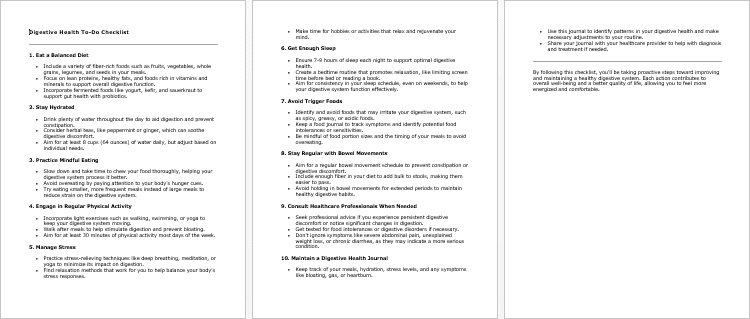
Digestive Health – FAQs

Digestive Health – Salespage Content
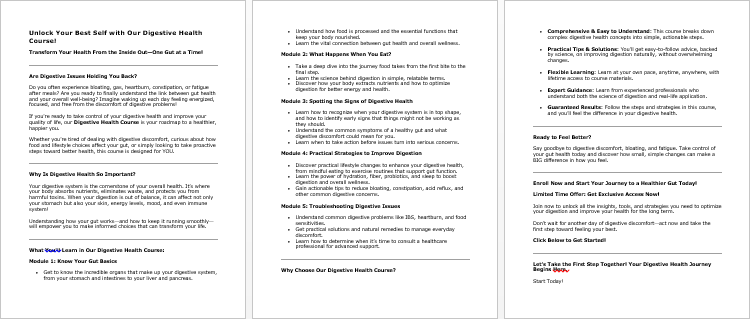
Package Details:
Word Count: 23 566 Words
Number of Pages: 98
Digestive Health – Bonus Content
Checklist
Word Count: 532 words
FAQs
Word Count: 1150 words
Salespage Content
Word Count: 7682 words
Total Word Count: 32 060 Words
Your PLR License Terms
PERMISSIONS: What Can You Do With These Materials?
Sell the content basically as it is (with some minor tweaks to make it “yours”).
If you are going to claim copyright to anything created with this content, then you must substantially change at 75% of the content to distinguish yourself from other licensees.
Break up the content into small portions to sell as individual reports for $10-$20 each.
Bundle the content with other existing content to create larger products for $47-$97 each.
Setup your own membership site with the content and generate monthly residual payments!
Take the content and convert it into a multiple-week “eclass” that you charge $297-$497 to access!
Use the content to create a “physical” product that you sell for premium prices!
Convert it to audios, videos, membership site content and more.
Excerpt and / or edit portions of the content to give away for free as blog posts, reports, etc. to use as lead magnets, incentives and more!
Create your own original product from it, set it up at a site and “flip” the site for megabucks!
RESTRICTIONS: What Can’t You Do With These Materials?
To protect the value of these products, you may not pass on the rights to your customers. This means that your customers may not have PLR rights or reprint / resell rights passed on to them.
You may not pass on any kind of licensing (PLR, reprint / resell, etc.) to ANY offer created from ANY PORTION OF this content that would allow additional people to sell or give away any portion of the content contained in this package.
You may not offer 100% commission to affiliates selling your version / copy of this product. The maximum affiliate commission you may pay out for offers created that include parts of this content is 75%.
You are not permitted to give the complete materials away in their current state for free – they must be sold. They must be excerpted and / or edited to be given away, unless otherwise noted. Example: You ARE permitted to excerpt portions of content for blog posts, lead magnets, etc.
You may not add this content to any part of an existing customer order that would not require them to make an additional purchase. (IE You cannot add it to a package, membership site, etc. that customers have ALREADY paid for.)
Related Products That May Interest You
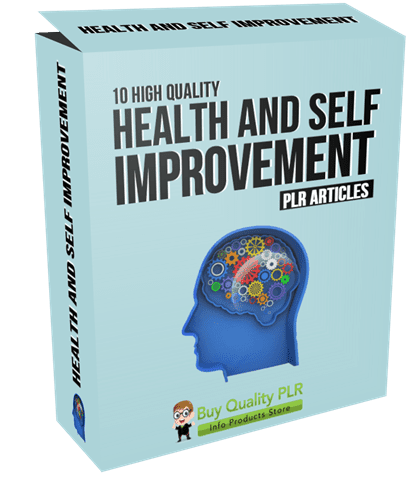
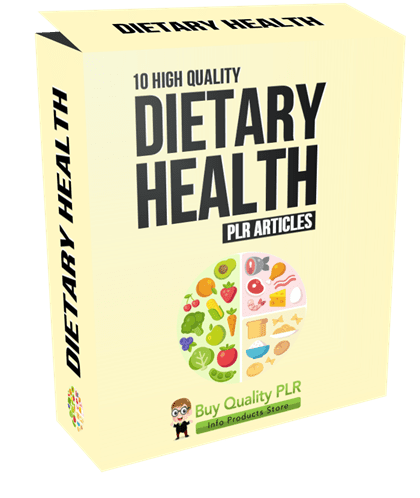

Share Now!

